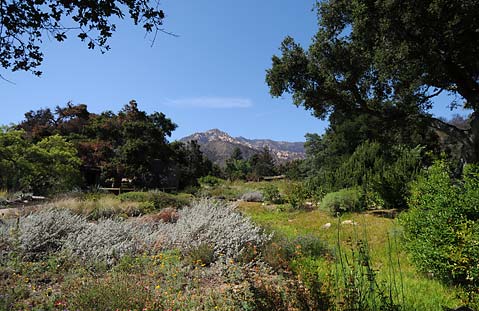Two Views of the Garden
Opinions Clash as Vote Nears on Botanic Garden Vital Mission Plan

I have recently become aware that on May 4, the Santa Barbara County Board of Supervisors will be voting on whether or not to approve the Vital Mission Plan for the Botanic Garden. While the majority of the county supports this plan, a small minority, mainly residents of the Mission Canyon area, has slowed the approval process through self-serving appeals based on false accusations. I feel it is my duty, as a county native and long-standing resident, to address these claims.
First, opponents have claimed that aspects of the plan, specifically construction of new facilities and more accessible trails and pathways, will increase fire risks faced by Mission Canyon residents and the Garden. I am not down-playing the fact that they are in a high-risk fire area. Quite the opposite: In looking at the past few years, it’s clear that a plan to improve fire safety in Mission Canyon is desperately needed.
The Vital Mission Plan includes sprinkler installation, turnarounds for fire trucks, fire-resistant building materials, an improved evacuation plan and drills, improved emergency water access, and waterline improvements. The County Fire Department has publicly stated that these projects will seriously reduce fire danger and increase response time. I ask you: Who better to know about fire safety than the fire department?
Second, concern has been raised that the plan will destroy the Garden’s significance as an historical landmark. I am confident that those who have made such claims are unaware or refuse to recognize the Garden’s true mission. It is not just a pretty park in a residential area. Long before it was surrounded by houses, the Garden was established as a research, education, and conservation center to preserve open space and to study California ecosystems and plants.
The Garden is an historic site, and it is accredited by the American Association of Museums as one of only 30 “living museums” in the nation. The Vital Mission Plan seeks to preserve this function. It proposes an additional 25,800 square feet of new facilities: half the size of a football field. These facilities are planned for construction within the footprint of existing buildings.
This is not a development or real estate venture. This is nothing—a mere cup in the cupboard, a closet in a house. When looking at the amount of residential development that has sprung up in the Mission Canyon area over the years, this seems like an extremely inconsequential request. For the most part, the objections to the Vital Mission Plan are baseless: unsubstantiated and misinformed accusations presented as credible fact, but really only disgruntled complaints from a small group of residents who fear that their quiet neighborhood “park” will no longer be purely theirs to enjoy. — Kristina Keeler
Plan Vandalizes Masterpiece of Landscape Architecture
The first step to stopping the damage being done at the Santa Barbara Botanic Garden (SBBG) is for the County Board of Supervisors to deny the Garden’s expansion plans, uphold the Historical Landmarks Advisory Commissions decisions, and send the plans back for a downsized redesign sensitive to the environment.
In the county’s Environmental Thresholds and Guidelines Manual, the term “environment” is defined as “the physical conditions which exist in the area which will be affected by a proposed project including land, air, water, minerals, flora, fauna, ambient noise, objects of historic or aesthetic significance.”
Decisions by the departing director, the interim manager, and the Board of Trustees are causing the SBBG to lose its national prestige. The work of a great American master is being vandalized. The expansion plan’s size and placement significantly diminish the SBBG’s historic and aesthetic value. The housing and road are Class I destructive forces to the registered archeological site. The Terrace Project, pavers, and buildings on the landmark also are Class I impacts, which the mitigation measures inadequately address.
In its Articles of Incorporation, the SBBG is a “natural history garden.” It is also an example of the sublime landscape architecture of Lockwood de Forest III and Beatrix Farrand. The genius of the landscaping is its emphasis on strong design that includes the setting, historical resources, and overall effect of the native California plantings.
Historical and cultural resources are considered non-living endangered species. The SBBG is a living and non-living endangered species! The SBBG management agreed to expansion guidelines clearly intended to save the historic landscape design while allowing for the display and outdoor education and research to go on as always. The SBBG is ignoring this resolution. This is being noticed nationally and commented on.
In November, 2009, the Cultural Landscape Foundation in Washington, D.C. put the SBBG on its list of most at-risk American public landscapes. The Jan./Feb./March 2010 issue of Pacific Horticulture features the SBBG in “At Risk: An Historic Landscape.” Garden Design magazine, April 2010, devotes four pages to the genius of the Garden’s landscape architecture, with biographies of de Forest and Farrand. “Were there no experts available when the Botanic Garden began the destruction of the Meadow?” asked a visiting professional in January, noting the over-watered English lawn marring the iconic Meadow. “We are hopeful that some kind of wisdom will prevail in beautiful Santa Barbara to reverse the unfortunate design of the ‘improved’ Botanic Garden and return this national treasure to its original natural beauty!”
The SBBG’s fate lies in the hands of the Board of Supervisors on May 4, and on a return to the vision of the Garden’s creators by a new director and a new Board of Trustees. — Paulina Conn



